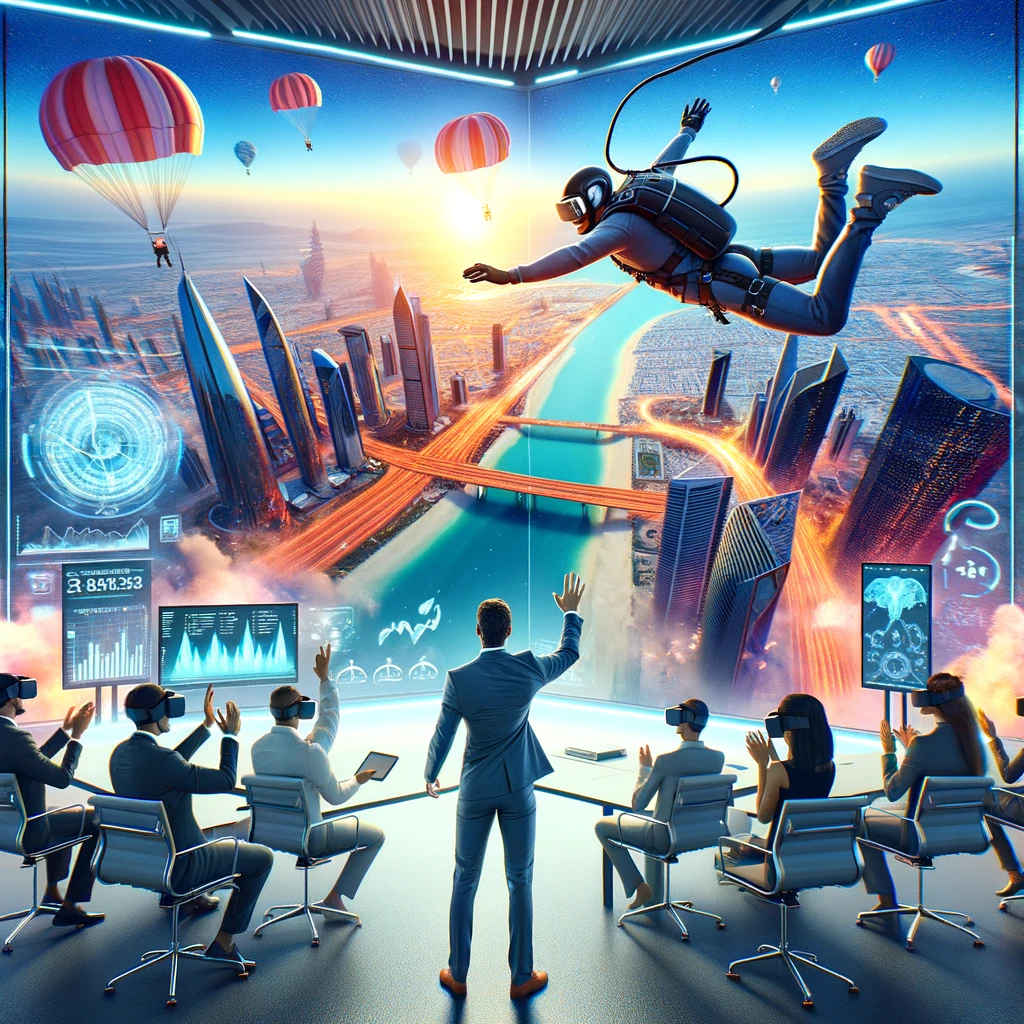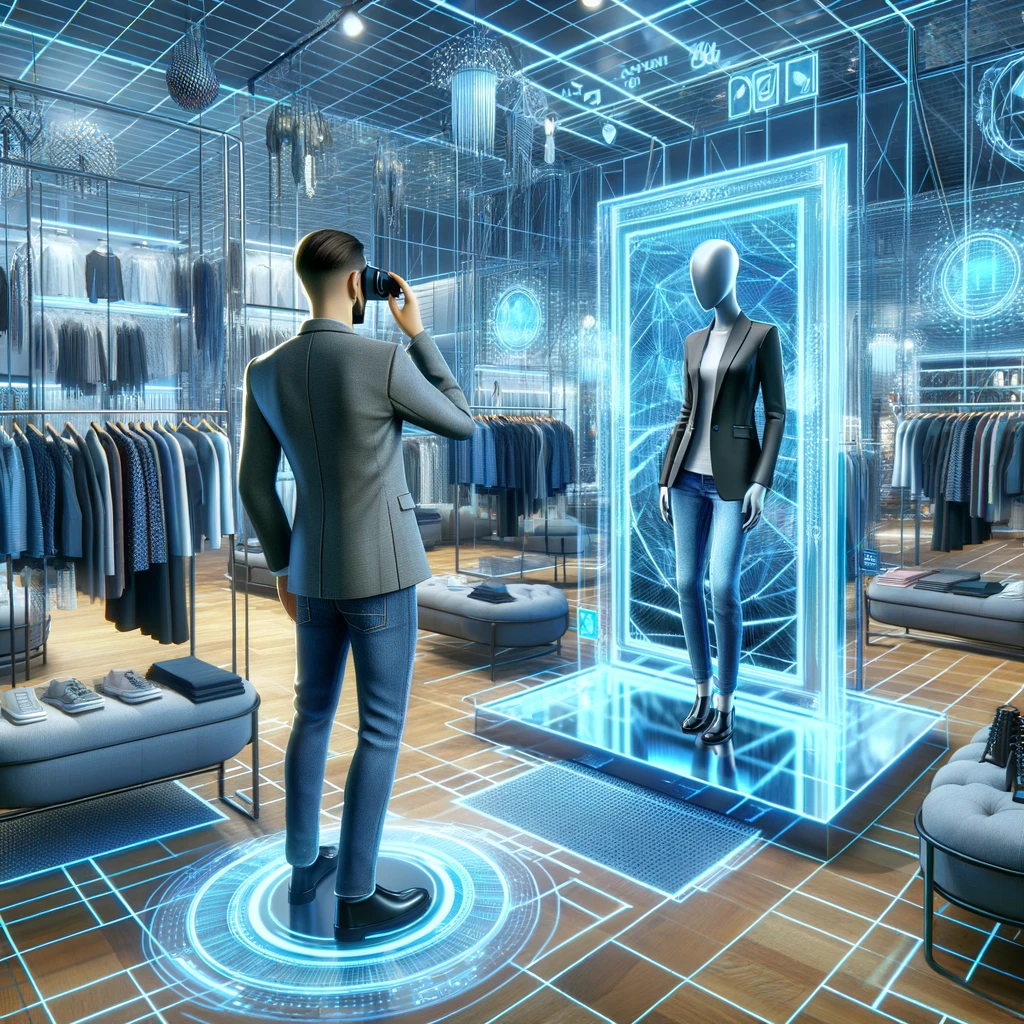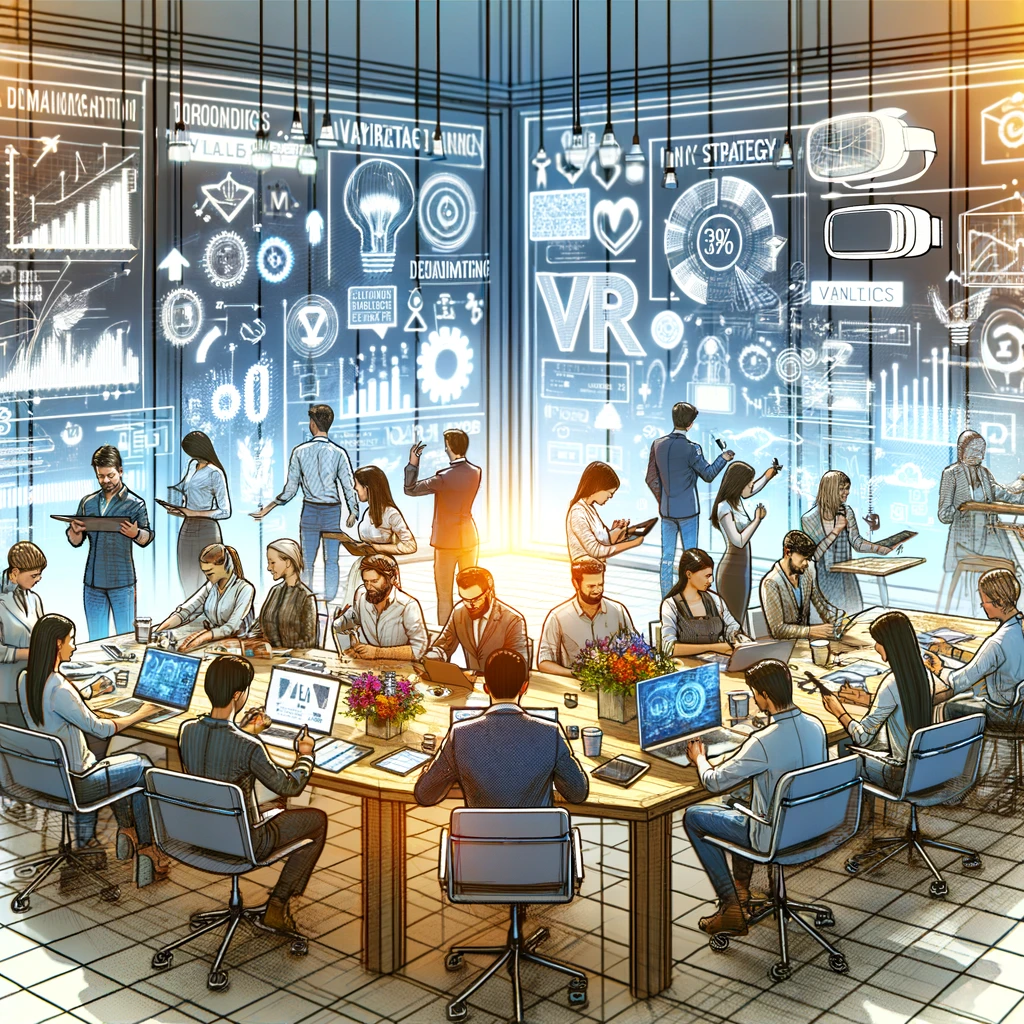Introduction
Imagine stepping into a world where you can climb the tallest mountains, explore the deepest oceans, or walk on the moon, all from the comfort of your home. This isn’t just a dream; it’s becoming reality thanks to virtual reality (VR) technology. In recent years, VR has taken giant leaps forward, making what once seemed like science fiction, a very real part of our lives.
Companies big and small, from Samsung and Facebook to Google, are racing to lead the VR revolution. They’re not just dabbling in VR for fun—they’re investing billions of dollars. Why? Because they believe VR has the power to change the way we live, work, and play, especially in how we connect with the digital world.
Virtual reality is not just about gaming or entertainment anymore. It’s about bringing experiences to life in a way that was previously unimaginable. Imagine shopping for a new house and being able to take a virtual tour of homes on the other side of the globe, or trying on clothes without ever stepping foot in a store. These experiences are just the beginning of what VR has in store for us, especially in the realm of digital marketing.
As we stand on the brink of this new era, it’s clear that VR is more than just a passing trend—it’s a technological evolution that will redefine our digital experiences. And as these virtual worlds become an integral part of our physical reality, the possibilities for creativity, connection, and commerce are limitless. Let’s embark on this exciting journey to discover how VR is set to revolutionize digital marketing, making the impossible, possible.

The Experience Revolution
Welcome to the future of marketing, where your adventures begin not just outside, but within the digital realms created by virtual reality (VR). This is the dawn of the Experience Revolution, a transformative era where marketing is not merely seen or heard but lived and breathed.
Imagine being part of a thrilling skydive over the breathtaking landscapes of Abu Dhabi, feeling the rush of the wind and the exhilaration of the free fall. But here’s the twist: you’re not actually skydiving. You’re experiencing it all through the magic of VR, from the comfort of your living room. This is the power of immersive experiences in marketing, brought to life by companies that dare to dream big, like Red Bull. They’ve taken us on incredible journeys from outer space back to Earth, and now, with VR, they’re setting the stage for us to not just watch, but to be part of the action.
Virtual reality in marketing is about erasing the boundaries between the consumer and the experience. It’s about making the impossible, possible; turning the imagined into the experienced. Through VR, brands can create deeply engaging narratives that allow customers to step into worlds beyond their imagination. Whether it’s exploring distant planets, walking through future cities, or standing atop virtual mountains, VR brings stories to life in a way that words or traditional media could never convey.
This revolution is not just about spectacle; it’s about connection. By immersing users in experiences, brands can forge emotional bonds that transcend the screen. It’s a new frontier for engagement, where every moment is an opportunity for interaction and every experience is a journey shared.
The Experience Revolution is here, reshaping the landscape of digital marketing with every virtual step we take. It’s a call to adventure for brands and consumers alike, inviting us all to dive into the wonders of what virtual reality has to offer. Let’s embrace this journey together, and see where this incredible technology can take us.

VR and E-Commerce
Step into the future of shopping with virtual reality (VR), where the convenience of e-commerce meets the immersive experience of retail shopping. Imagine entering a chic, digitally crafted boutique from the comfort of your home. This is the new frontier of shopping, where fashion and technology blend seamlessly to offer an unparalleled shopping experience.
In this digital boutique, you’re not just browsing; you’re experiencing. With a VR headset, you can try on outfits without the hassle of changing rooms or the limitation of physical inventory. Each piece of clothing adapts to your avatar, allowing you to see how it looks and moves with you. Want to see how that dress fits from the back or how those jeans look from a different angle? Simply turn around in front of a virtual mirror and view your reflection, just as you would in a real store.
But VR shopping is more than just visual. Advanced VR technologies are starting to simulate textures, so when you reach out to touch a silk dress or a leather jacket, you’ll feel the smoothness or the graininess under your fingertips. This sensory feedback adds a new dimension to online shopping, bridging the gap between the digital and the physical.
This isn’t just a dream; it’s the beginning of a revolution in e-commerce. As technology advances, the line between online and in-store shopping blurs, offering a hybrid experience that combines the best of both worlds. You can explore endless aisles of clothing, accessories, and shoes, all without leaving your living room. No more guessing if an outfit will fit or look good; VR brings certainty and excitement back into shopping.
Welcome to the era of VR e-commerce, where every visit to an online store is an adventure, every purchase is informed, and the world of fashion is at your fingertips. The future of shopping is here, and it’s more vivid, tactile, and exciting than ever before. Let’s embrace this journey into the virtual, where every shopping trip is an experience to remember.

VR’s Role in Marketing Strategies
As we venture further into the digital age, virtual reality (VR) emerges not just as a tool for entertainment, but as a cornerstone in the evolution of marketing strategies. The essence of marketing is to connect with audiences in meaningful ways, and VR opens up a universe of possibilities for achieving this like never before.
In the vibrant world of VR marketing, businesses are no longer content with simply catching the eye; they aim to captivate the mind and soul. Imagine being transported to a world crafted by a brand, where you can interact with products, immerse yourself in brand stories, or embark on adventures that resonate with the brand’s ethos. This is the power of VR in marketing—a power that is both transformative and boundless.
Creative teams across the globe are now harnessing this power to forge deeper connections with their audiences. In modern, technology-filled offices, these teams gather, their minds buzzing with ideas that blend creativity with cutting-edge technology. They strategize, brainstorm, and plan campaigns that are not just campaigns, but experiences—ones that promise to leave lasting impressions on the viewer.
The role of VR in marketing is multifaceted. It serves as a bridge between imagination and reality, enabling brands to bring their visions to life in the most immersive ways possible. It allows for storytelling that’s not just heard or seen but felt. This level of engagement transforms passive viewers into active participants, creating a profound connection that traditional media cannot replicate.
Moreover, VR marketing is not confined to a niche audience; it’s accessible and scalable, adaptable to different industries, from fashion and travel to real estate and education. Whether it’s a virtual tour of a dream home, a front-row seat at a fashion show, or a hands-on educational program, VR brings brands closer to their audience, transcending physical and geographical barriers.
The strategic integration of VR into marketing plans signifies a shift towards experiential marketing. It’s an acknowledgment that in a world where attention is the new currency, the richest experiences are the most valued. As brands and marketers, the journey into VR is not just about keeping pace with technology but about leading the charge towards a future where experiences are not just offered but shared, not just created but lived.
As we look forward, the potential of VR in marketing is only limited by our imagination. The question for businesses now is not if they should incorporate VR, but how creatively and effectively they can do so. The era of experiential marketing is upon us, and VR is leading the way, offering a canvas as vast as the virtual worlds it creates. It’s time for brands to step into these worlds, to explore, engage, and connect in ways never thought possible. The future is here, and it’s virtually unlimited.
Challenges and Opportunities
In the exhilarating journey of integrating virtual reality (VR) into digital marketing, we encounter a landscape filled with both challenges and opportunities. Like two sides of the same coin, each challenge presents a door to new possibilities, and every opportunity brings its own set of hurdles.
Navigating the Challenges
The path of VR in marketing is not without its obstacles. One of the foremost challenges is the technological limitations that still exist. Despite rapid advancements, VR technology requires more refinement to become fully immersive and accessible to a broader audience. High costs of VR equipment and development can also pose significant barriers, limiting the technology’s reach to those who can afford it.
Moreover, there’s a steep learning curve associated with VR. Both marketers and consumers must acquaint themselves with this new medium. For marketers, crafting compelling VR content requires a blend of storytelling prowess and technical expertise. For consumers, becoming comfortable with using VR headsets and navigating virtual environments can take time.
Embracing the Opportunities
Amidst these challenges lie tremendous opportunities. VR offers an unparalleled level of immersion, enabling brands to create deeply engaging and memorable experiences. Through VR, customers can interact with products and services in a simulated environment, providing them with a better understanding and feel than traditional online or even in-store experiences.
This immersive capability opens up innovative avenues for advertising and brand storytelling. Marketers can transport customers to virtual worlds, tell stories in dynamic and interactive ways, and create emotional connections that transcend the physical barriers of traditional marketing channels.
Furthermore, VR paves the way for personalized experiences at scale. Brands can tailor virtual experiences to individual preferences and behaviors, offering a level of customization that was previously unattainable. This not only enhances customer satisfaction but also boosts engagement and loyalty.
Striking a Balance
The future of VR in digital marketing is a thrilling prospect that requires navigating a delicate balance between leveraging emerging opportunities and overcoming existing challenges. As technology evolves and becomes more integrated into our daily lives, the potential for VR in marketing will continue to expand.
Businesses that are willing to embrace these challenges, invest in understanding and developing VR content, and explore the vast potential of immersive experiences will be the pioneers in this new frontier. They will not only set the standard for what is possible in digital marketing but also redefine how brands connect with their audiences in the digital age.
As we look towards this future, it’s clear that the journey of VR in marketing is just beginning. With each challenge overcome, we unlock new possibilities, pushing the boundaries of creativity, engagement, and connection. The balance between these challenges and opportunities will shape the future of digital marketing, promising a landscape that is as dynamic and evolving as the technology itself.
Conclusion
As we venture through the evolving landscape of digital marketing, the advent of virtual reality (VR) presents a transformative shift, marking the beginning of a new era. VR is not just another technological advancement; it’s a revolutionary tool that has the potential to redefine how brands interact with their audiences, offering immersive experiences that were once the stuff of science fiction.
The journey of integrating VR into digital marketing is an exciting voyage of discovery, experimentation, and innovation. It challenges traditional marketing paradigms and pushes the boundaries of creativity and engagement. Through VR, brands can create captivating narratives, offer hands-on experiences, and foster a deeper emotional connection with their customers, turning ordinary interactions into memorable adventures.
However, this journey is not without its hurdles. The challenges of technological limitations, high development costs, and the need for widespread user adoption are significant but not insurmountable. These obstacles invite us to innovate, to find solutions that make VR more accessible, and to craft experiences that resonate with a broad audience.
The opportunities VR presents for digital marketing are vast and varied. From immersive storytelling and virtual showrooms to interactive ads and personalized shopping experiences, VR allows marketers to engage with consumers in ways that were previously unimaginable. It offers a new canvas for creativity, a new platform for connection, and a new frontier for marketing.
As we stand on the brink of this exciting future, it’s clear that VR is more than just a passing trend—it’s a pivotal force in the next evolution of digital marketing. For brands willing to explore this uncharted territory, the potential is limitless. The real question is not if VR will become integral to digital marketing, but how quickly we can adapt and harness its power to create experiences that truly resonate with our audiences.
The future of digital marketing is immersive, interactive, and incredibly exciting. With VR, we’re not just reaching out to our audience; we’re inviting them into our world, offering them a seat at the table, and embarking on a journey together. This is the promise of VR in digital marketing—a promise of more engaging, memorable, and meaningful connections with consumers around the globe.
As we look forward, let’s embrace the challenges and opportunities that VR brings with enthusiasm and creativity. Let’s continue to push the boundaries of what’s possible, explore new horizons, and create experiences that not only capture the imagination but also the hearts of our audience. The era of VR in digital marketing is just beginning, and the possibilities are as limitless as our imagination.
